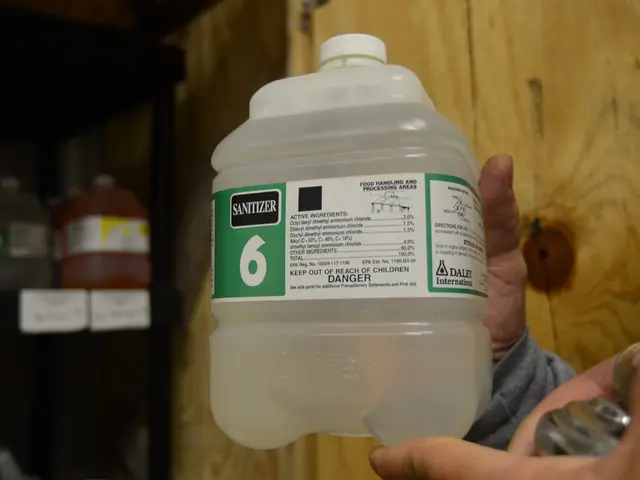Sexually Transmitted Diseases Transmissible via Lip-to-Lip Contact
In the realm of sexually transmitted diseases (STDs), it's not just intimate contact that poses a risk. Several STDs can be transmitted through kissing, particularly when active lesions or symptoms are present. Here's a breakdown of some of the most common STDs that can be spread this way:
1. **Herpes Simplex Virus Type 1 (HSV-1)**: This is the most frequent example of an STD spread through kissing. It causes oral herpes, often resulting in cold sores or fever blisters around the mouth and lips.
2. **Syphilis**: Although less common, syphilis can also be transmitted through kissing if there are active lesions present.
3. **Gonorrhea**: While rare, gonorrhea can potentially be spread through kissing if there is a throat infection.
4. **Cytomegalovirus (CMV)**: This virus can be transmitted through saliva, but it is not as commonly associated with kissing as HSV-1.
It's essential to remember that the transmission of these diseases through kissing is generally less common than through other forms of sexual activity. However, caution should be exercised if there are active lesions or symptoms present.
Contrary to popular belief, a majority of STIs are not transmitted through kissing. Diseases such as chlamydia, gonorrhea, HIV, chancroid, pubic lice, and most diseases spread by kissing fall into this category.
Another significant concern is the rise of oropharyngeal cancer cases in the U.S., which are primarily caused by HPV. HPV can be transmitted in rare cases through oral contact or infected saliva, but the most common way is through direct contact with the genitals.
The World Health Organization (WHO) reports that approximately 3.7 billion people under the age of 50 have HSV-1 infections worldwide, most acquired in childhood. Most people with oral herpes have an HSV-1 infection, causing sores, painful blisters, or ulcers around the mouth.
Syphilis, on the other hand, is a bacterial STD that can spread through direct contact with a syphilis sore, which can develop on the genitals, in the mouth, or on the lips.
Both HSV-1 and HSV-2 cause lifelong infections and can spread through oral-to-oral contact such as kissing. It's crucial to be aware of the risks and take necessary precautions to protect yourself and others.
[1] Centers for Disease Control and Prevention. (2021). Transmission of STDs. Retrieved from https://www.cdc.gov/std/life-stages/teen-young-adult-male/transmission.htm [2] Mayo Clinic. (2021). Oral herpes. Retrieved from https://www.mayoclinic.org/diseases-conditions/oral-herpes/symptoms-causes/syc-20351751 [3] Centers for Disease Control and Prevention. (2021). Syphilis. Retrieved from https://www.cdc.gov/std/syphilis/stdfact-syphilis.htm [4] National Institute of Dental and Craniofacial Research. (2021). Oral herpes simplex virus. Retrieved from https://www.nidcr.nih.gov/health-info/dental-topics/oral-herpes-simplex-virus
- Multiple STDs can be transmitted through intimate contact, but several can also be spread through kissing, particularly when active lesions or symptoms are present.
- Herpes Simplex Virus Type 1 (HSV-1) is the most frequent example of an STD transmitted through kissing, causing oral herpes with symptoms like cold sores or fever blisters.
- Syphilis, although less common, can also be transmitted through kissing if there are active lesions present.
- Gonorrhea is rare, but it can potentially be spread through kissing if there is a throat infection.
- Cytomegalovirus (CMV), while not as commonly associated with kissing, can be transmitted through saliva.
- Most STIs are not transmitted through kissing, with diseases such as chlamydia, gonorrhea, HIV, chancroid, pubic lice, and most diseases spread by kissing falling into this category.
- The rise of oropharyngeal cancer cases in the U.S. is primarily caused by HPV, which can be transmitted through oral contact or infected saliva but is most commonly perpetuated through direct contact with the genitals.
- The World Health Organization (WHO) reports that about 3.7 billion people under the age of 50 have HSV-1 infections worldwide, most acquired in childhood, leading to sores, painful blisters, or ulcers around the mouth.
- Syphilis is a bacterial STD that can spread through direct contact with a syphilis sore, which can develop on the genitals, in the mouth, or on the lips.
- Both HSV-1 and HSV-2 cause lifelong infections and can spread through oral-to-oral contact such as kissing, making it crucial to be aware of the risks and take necessary precautions.
- Asthma, obesity, diabetes, sclerosis, dermatitis, atopic, ulcerative colitis, Crohn's, oral cancers, alzheimers, HPV, and various health-and-wellness issues are not primarily linked to STDs but are important considerations for overall personal health.
- In the field of science, predictive models are being developed to help understand the transmission of STDs and identify potential risks, contributing to better health-and-wellness and sexual-health outcomes for individuals.




